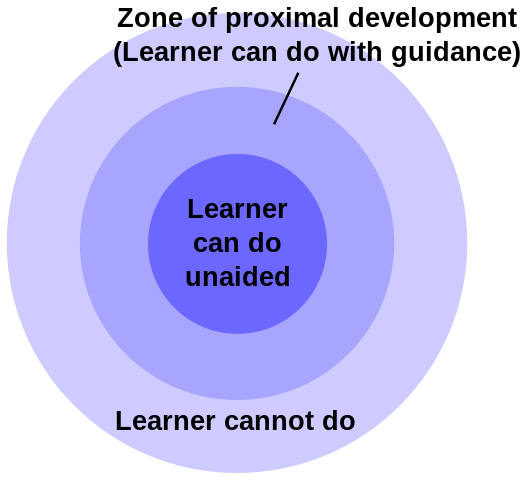Instructional Scaffolding and the Zone of Proximal Development (ZPD) are two interconnected concepts which play a vital role in language training and materials design. Let’s delve into both of the concepts and explore their significance in language training. Developed by psychologist Lev Vygotsky, these concepts are foundational in understanding how learners acquire new skills and knowledge within educational settings.
Instructional Scaffolding
It was in the 1920s that Vygotsky developed and documented his groundbreaking learning theories. Much later in 1976, David Wood, Gail Ross and Jerome Bruner revived Vygotsky and coined the term “scaffolding” to describe one of his key ideas. Scaffolding refers to the structured support and guidance that is provided by trainers to learners as they engage in the process of learning new concepts or skills. Instructional scaffolding is similar to learning to drive a car with an instructor. The instructor provides step-by-step guidance, ensures learner’s safety, and takes over the control of the car when necessary. Gradually, as the learner becomes more proficient, they will drive without intervention from the instructor. Over time, the role of the instructor is reduced, and the learner is able to drive alone.
Much like scaffolding supports the process of learning to drive a car, educational scaffolding offers temporary assistance to those engaged in challenging language tasks. The primary goal of scaffolding is to bridge the gap between a learner’s current abilities and the target skills they aim. Similar to learning to drive, scaffolding strategies are gradually reduced as learners gain confidence and proficiency with new target language, allowing them to become increasingly independent in activation phases and language production.
Language trainers use various scaffolding techniques, such as providing clear instructions, breaking down complex tasks into manageable steps, offering hints, modelling problem-solving processes, offering immediate feedback, asking questions. These techniques can also be implemented in the materials creation process. For example, a learning cycle will often begin with new language items displayed in a context, and later proceed from easier, highly scaffolded tasks, to harder, less scaffolded tasks. These strategies cater to learners’ specific needs, encouraging them to stretch their cognitive abilities and reach higher levels of achievement. Scaffolding is a dynamic process that adjusts to individual learners’ progress, ensuring that they are challenged enough to grow without feeling overwhelmed.
Zone of Proximal Development (ZPD)
The Zone of Proximal Development (ZPD) is like a swimming pool. The shallow end where a learner can stand and touch the ground represents what they can do on their own (the known zone). The deeper end, where the learner can no longer stand by themselves, is what the learner can achieve with assistance (the ZPD). The part of the pool still too deep, even with assistance, represents what cannot yet be learned.
In language training, the ZPD is a concept closely linked to scaffolding. The zone refers to the range of tasks that a learner cannot yet perform independently but can successfully complete with the guidance and support of a more knowledgeable individual, typically an educator or peer. The ZPD is the spot where learning is most effective, as it lies between what the learner can do on their own (the “actual development level”) and what they cannot do, even with assistance.

The ZPD recognizes that learners are not static in their abilities but rather in a state of transition. By engaging learners in tasks that fall within their ZPD, educators can effectively scaffold their learning experiences. As learners encounter challenges that are just beyond their current capabilities but within their ZPD, they are more likely to experience cognitive conflict, which stimulates growth and development.
Scaffolding and ZPD in Action:
Effective educators strategically integrate scaffolding techniques tailored to learners’ ZPD. For example, a teacher might use questioning to help a student critically analyze a text, providing just enough guidance to help the student navigate challenging concepts. Over time, as the student gains confidence and skills, the teacher might gradually reduce the level of questioning, allowing the student to take more ownership of the learning process.
In essence, scaffolding and ZPD form a dynamic partnership in education. Scaffolding supports learners in their ZPD, where they are optimally poised to make significant cognitive leaps. As learners progressively internalize knowledge and skills through guided support, they move from a dependence to an independence state, becoming capable of tackling complex tasks on their own. This harmonious interplay between scaffolding and the ZPD fosters a rich and rewarding learning experience that empowers learners to gradually take ownership of knowledge and skills.
ZPD image by Dcoetzee – Own work, CC0, https://commons.wikimedia.org/w/index.php?curid=20903046

No responses yet